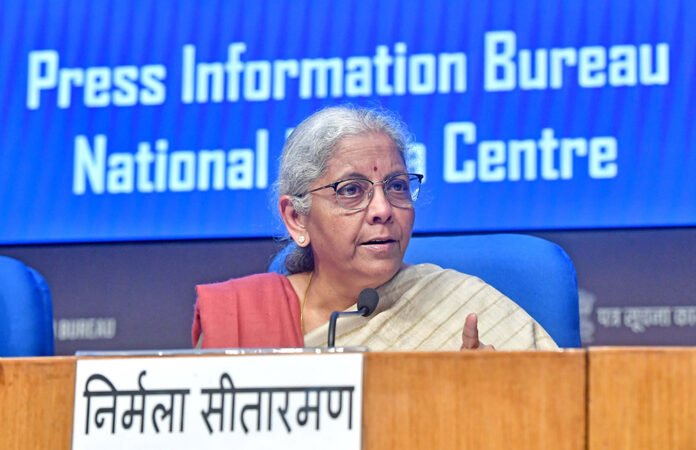The Union Budget for the financial year 2025-26 (FY’26), presented by Finance Minister Nirmala Sitharaman on 1 February 2025, provides an outlay of ₹6,81,210.27 crore for the Ministry of Defence (MoD). This represents an increase of ₹59,769.42 crore, or 9.53 per cent, over the current financial year’s budget estimates, making it the highest allocation among all ministries and departments of the central government.
However, on other parameters typically used to assess defence budgets, there is not much of a difference between the allocations for the current and the coming financial years. For both years, the budget estimates work out to 1.9 per cent of the Gross Domestic Product (GDP). As a proportion of total central government expenditure, next year’s allocation stands at 13.45 per cent, marginally higher than the current year’s 13.04 per cent.
Assessing the Defence Budget for FY’26
What, then, can one infer from the defence budget for FY’26? In the absence of an objective yardstick to determine how much would be considered adequate for defence, it is always safe to suggest that the budget allocation falls short of requirements and expectations, without delving into the specifics of the shortfall’s extent. This longstanding perspective on defence budgets, including the one for FY’26, is supported by empirical evidence and publicly available data.
The MoD budget is distributed across four Demands for Grant:
- Ministry of Defence (Civil)
- Defence Pensions
- Defence Services (Revenue)
- Capital Outlay on Defence Services
The additional ₹59,769.42 crore has been unevenly distributed across these categories. While this may not be surprising, what raises concerns is that the increased allocation will result in limited benefits to the budget heads responsible for the modernisation of the armed forces and ensuring their operational readiness at all times.
Revenue Expenditure for Defence Services
Let us begin with the Demand for Grant for the revenue expenditure of the Defence Services. The budget estimates for FY’26 allocate ₹3,11,732 crore to this category, which accounts for ₹28,959.63 crore, or 48.86 per cent of the total budget increase for the Ministry of Defence.
This Demand for Grant primarily covers salaries of service personnel, auxiliary forces, and civilians, which alone account for over 50 per cent of the revenue budget. The other budget heads under this Demand for Grant include Stores, Transportation’ Works (for infrastructure maintenance), and other expenditures, such as Military Farms; Ex-Servicemen Health Scheme; Inspection Organisation; Rashtriya Rifles; National Cadet Corps; Repair & Refit of Naval Vessels; Joint Staff; Special Projects of the Indian Air Force, and Defence Research and Development Organisation (DRDO).
Among these budget heads, the most significant is Stores, which covers expenditure on ration, clothing, ammunition, equipment maintenance, spares, and other ordnance stores. This budget head accounts for ₹15,790.75 crore (or 54.52 per cent of the revenue increase). However, budget documents available in the public domain do not specify how much of this will actually be directed toward operational expenses, such as the procurement of ammunition and maintenance of in-service equipment.
The relatively modest increase of ₹ 8,000 crore in the capital outlay for FY 2025-26 is also notable when compared to the previous year’s increase of ₹ 9,800 crore. This suggests that the procurement of new equipment, weapon systems, and platforms in the coming year will not be significantly different from what was observed this year
Evaluating the Increase Under Various Heads
While the ₹15,790.75 crore increase in the Stores budget head appears significant at first glance, it loses some of its impact when considered in the context of past allocations and actual expenditures. For instance, the total Stores allocation for the current year (FY ‘25) was ₹49,111.48 crore, which was ₹13,973.80 crore less than the actual expenditure of ₹63,085.28 crore in FY ‘24. This underestimation forced a revision of the Stores budget to ₹60,700.87 crore for the current year. Thus, in comparison with the revised estimates for the current year, the ₹49,111.48 crore allocation for FY ‘26 represents an increase of only ₹4,201.35 crore. This marginal increase is likely to be barely sufficient to cover the rising costs of ration, clothing, and other procurements under the Stores budget head.
The next highest beneficiary of the enhanced allocations under the Demand for Grant for revenue expenditure of the defence services is the Agnipath Scheme, for which the allocation has surged by an astonishing 84.63 per cent, rising from ₹ 5,979.28 crore in the current financial year to ₹ 11,039.51 crore for FY 2025-26. This marks an even more dramatic increase of over 258 per cent from the actual expenditure of ₹ 3,080.40 crore recorded in the financial year 2023-24. Given that the budget estimates for the current year had to be revised upwards from ₹ 5,979.28 crore to ₹ 7,472.08 crore, it is reasonable to anticipate that even the enhanced allocation for FY 2025-26 may not suffice. This substantial financial commitment unequivocally dispels speculations about the future of the Agnipath Scheme, which was met with widespread criticism upon its introduction in June 2022.
The increases in other budget heads within the Demand for Grant for revenue expenditure of the defence services are either negligible or insignificant, not warranting specific mention—except for the budget head allocated to Repairs and Refit of naval vessels, which has been increased by a modest ₹ 25.87 crore.
The second highest recipient of the enhanced allocation for FY 2025-26 is the Demand for Grant for Defence Pensions, which has been augmented by ₹ 19,500 crore. This constitutes 33 per cent of the total additional funds provided in the budget for the upcoming financial year. The overall allocation for defence pensions stands at ₹ 1,60,795 crore, accounting for 23.6 per cent of the total defence budget.
Although the Ministry of Defence (MoD) does not explicitly acknowledge it, one of the key motivations behind the introduction of the Agnipath Scheme was to curb the ballooning defence pension expenditure. While it is undeniable that the scheme will, over time, alleviate financial pressure on the pension budget, its long-term impact remains uncertain. In the interim, the pensions budget is expected to remain at current levels for the foreseeable future.
The total allocation for DRDO remains below 4 per cent of the total defence budget for the third consecutive year. Given these figures, it would be overly optimistic to expect any significant breakthroughs in defence research and development in the coming financial year
The third highest beneficiary of additional funds allocated in the budget for FY 2025-26 is the Capital Outlay for Defence Services. At ₹ 1,80,000 crore, the capital budget has been increased by ₹8,000 crore, or 4.65 per cent, compared to the budget estimate of ₹ 1,72,000 crore for the current financial year. However, it is important to note that the MoD was unable to utilise the entire allocated budget this year, leading to a downward revision to ₹ 1,59,500 crore. When compared to this revised estimate, the increase for FY 2025-26 works out to a more substantial 12.85 per cent.
Behind these figures lies a stark reality: of all the budget heads within this Demand for Grant, only three—Aircraft and Aeroengines (₹ 8,336.20 crore), Other Equipment (₹ 901.01 crore), and Naval Fleet (₹ 590.95 crore)—have witnessed meaningful enhancement. The allocation to Joint Staff has also been increased by ₹ 999.84 crore, but details regarding the total sum allocated to it remain unavailable. Under all other budget heads, increases have been either modest or even negative. A particularly perplexing development is the reduction in allocation for Naval Dockyards/Projects by ₹ 2,330 crore, for reasons that are not immediately clear.
The relatively modest increase of ₹ 8,000 crore in the capital outlay for FY 2025-26 is also notable when compared to the previous year’s increase of ₹ 9,800 crore. This suggests that the procurement of new equipment, weapon systems, and platforms in the coming year will not be significantly different from what was observed this year.
A fundamental anomaly in India’s defence budget structure is that while the outlay for the Defence Research and Development Organisation (DRDO) is included within the defence services budget, the outlay for crucial organisations like the Coast Guard and Border Roads Organisation—both integral to India’s military capability—is grouped under the civil departments of the Ministry of Defence.
India’s ambition to achieve self-reliance in defence production hinges on indigenous design, development, and manufacturing of state-of-the-art military equipment. While DRDO remains the country’s premier R&D institution in this domain, its attempts to engage the private sector in defence research and development have yet to yield results commensurate with the expectations of the armed forces. Recognising this, the government constituted a nine-member committee under K. Vijay Raghavan in August 2023 to overhaul the organisation. Media reports suggest that the committee’s recommendations are being implemented, but the impact of these reforms is unlikely to be immediate.
The allocation for DRDO in FY 2025-26 has increased by ₹ 1,845 crore under the revenue segment and ₹ 1,716 crore under the capital segment. However, the total allocation for DRDO remains below 4 per cent of the total defence budget for the third consecutive year. Given these figures, it would be overly optimistic to expect any significant breakthroughs in defence research and development in the coming financial year.
The Coast Guard and Border Roads Organisation have also been affected by the overall financial constraints, though, based on their track record, they are more likely to optimise the funds allocated to them. Their respective budgets have been increased by ₹ 2,024.50 crore and ₹ 674.50 crore, taking their total allocations to ₹ 9,676.70 crore and ₹ 8,479.50 crore. Of this, ₹ 5,000 crore has been earmarked for capital expenditure by the Coast Guard, while the Border Roads Organisation has been allocated ₹ 7,134.50 crore for capital projects—an increase of ₹ 1,500 crore and ₹ 634.50 crore, respectively, over the current year’s allocations.
Takeaways
While the nearly ₹ 60,000 crore increase in the proposed outlay for FY 2025-26 may appear substantial, its distribution is highly uneven. When viewed in the context of India’s pressing need to bolster its military capabilities against adversaries to the north, west, and increasingly, the east, the allocation falls short of what is required. To be fair, however, financial constraints are not the sole impediment to India’s defence modernisation. What is critically needed is a financially sustainable and strategically sound comprehensive defence modernisation plan. Yet, inexplicably, this remains a low-priority area for the defence establishment.
–The writer is a former Financial Advisor (Acquisition), Ministry of Defence. The views expressed are personal and do not necessarily reflect the views of Raksha Anirveda






